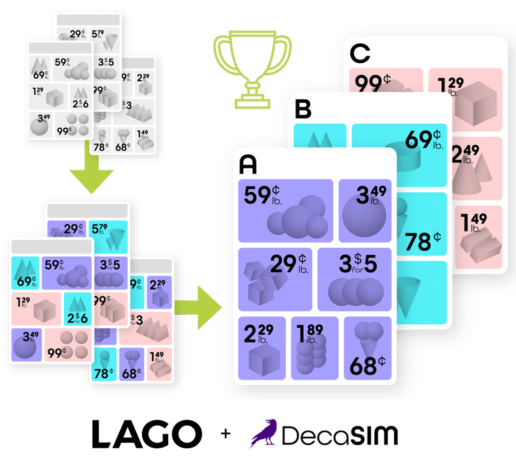Can AI help retail?
Can AI help retail? A no-nonsense strategy for success in the AI revolution
A mere eleven months ago, OpenAI launched the public version of its AI-based, large language model, ChatGPT. In that short time, the noise surrounding AI has dominated the media, boardroom conversations, and almost every social gathering on the planet. Retail advertising and marketing directors everywhere are inundated with questions. “What are we doing about artificial intelligence – and how will we survive without it?”
Thankfully, Comosoft and its AI development partner, DecaSIM, have a practical answer. They now offer a clear path for retailers searching for real-world AI solutions, relieving the pain of turning vast amounts of complex data into meaningful, more cost-effective marketing campaigns. In a recent case study, a leading regional grocer implemented a live test of Comosoft’s marketing automation system, LAGO, in combination with DecaSIM’s AI-based data analysis tools, generating positive results from week one. By optimising which promotions to feature in its advertising and creating more customer engagement, the company demonstrated increased weekly sales and an eight percent increase in EBITDA profitability.
Artificial intelligence for the rest of us
Much public anxiety over AI stems from common misperceptions about the technology. ChatGPT and other “generative” AI systems often look for patterns in vast amounts of unstructured data – meaning there are no preexisting identification tags or metadata to help us sort or classify them. The Comosoft/DecaSIM AI model is based on a smaller set of structured data, such as the known purchase history of specific products, prices, and seasonal buying patterns. The AI tool uses the data to solve equations to create new (and precious) metadata describing shoppers’ behavior and preferences about specific products.
In other words, the AI is finding meaningful inferences from the data based partly on the domain knowledge of advertising and marketing professionals. It does so with volumes of data that, while not as vast as the trillions of data parameters required by generative AI systems like ChatGPT are still too large for humans to analyse without help.
All this puts the Comosoft/DecaSIM approach in the category sometimes known as “Narrow AI,” or artificial intelligence designed to perform specific tasks. This differs from purportedly self-aware, artificial general intelligence or AGI, which is still hypothetical at best. However, since simplified tasks are critical to retail success, advertising and marketing directors have little to fear and much to gain. The belief that AI is taking over from humans is offset by a growing awareness that AI can be a critical part of any retail marketing team.
During the testing process with retailers, DecaSIM co-founder Chris Antipa noted that advertising and marketing departments are finding their work enhanced, not threatened.
“There’s always this natural pushback, with people saying, ‘Hey, computers are coming for my job.’ But as time passes, they begin to understand what the AI is doing for them and talk about the platform as a teammate. They even joke that they should give it a nickname.”
Putting AI to work
The combination of DecaSIM’s AI tools and Comosoft LAGO can only be described as a high-impact data solution. LAGO already automates various vital functions for retailers, including integration of campaign planning, numerous data sources, and streamlined production of print and digital campaigns – including multiple regional versions of each catalog, flyer, or digital equivalent. Using AI elevates that process even further. Historically, structured data from LAGO and other sources are fed to the DecaSIM system, deriving meaningful shopper habits and preferences for specific products and product categories. This enhanced metadata is fed back into LAGO, providing an objective basis for promoting particular products at specific locations and times of the year.
The results have been remarkable. Co-founder Doug Edmonds recounted the response of one retail executive, who said the DecaSIM/LAGO combination “made every ad like a holiday ad,” thanks to the system’s ability to anticipate shoppers’ preferences and product attributes. “The data we utilize contain context and meaning hidden to most of the retail world,” Edmonds continued. “AI uses those data to define that context and meaning, rate its importance, and add all that to the metadata for each product and category.”
The LAGO approach, which integrates marketing-relevant data from product information management (PIM), digital asset management (DAM), and other sources, is ideally suited to optimise the new DecaSIM data. “Traditionally, more than half of our implementations start with some rich data feed,” said Comosoft Product Manager Steve May. “Typically, this is a collection of product SKUs, digital assets, and offers. With DecaSIM, the data are enhanced before we even get it.”
This is especially important to advertising and marketing directors at the planning stage of a campaign. LAGO’s whiteboarding capability already gives them an overview of which products to feature prominently based on criteria such as regional availability, profit margin, and sales history. With the addition of DecaSIM data, they also can have reliable indicators of what shoppers will more likely purchase, including their preferences for related or alternative products.
“LAGO and DecaSIM are both ‘painkillers’ for retail advertising and marketing professionals,” said Comosoft US President Randy Evans. “One stops the pain of integrating PIM, DAM, and other data to execute campaigns at scale. The other removes the guesswork of which products are more likely to sell.”
The future of AI in retail marketing
The success of this approach is not limited to the grocery market. Retailers depend heavily on regular foot traffic and a known population of frequent shoppers – a dimension that fits everyone from home improvement and hardware retail chains to fashion and lifestyle brands. Knowing objectively what shoppers want and advertising accordingly is a holy grail for all retail marketers – one that DecaSIM’s AI can find and LAGO can implement, even down to the local level and on multiple print and digital platforms.
The two companies are actively engaged in combining and expanding these capabilities shortly. Some of these enhancements will be the subject of next month’s article.
Why you absolutely need a digital catalog
Why you absolutely need a digital catalog
Just like when a patron sits down to eat at a restaurant and expects to see some menu, your customers want to know what your brand has available for purchase. Diners at a restaurant want to read descriptions of what’s on the menu, complete with ingredients and information like potential allergens and prices.
With your catalog, your customers want to see specific details for each product they might be interested in, with a thorough description, price list, and eye-catching photos that help them see how your products can fit into their lives.
But here’s the thing: Many restaurants have shifted their menus online over the past few years. With QR codes posted at every table, restaurant patrons can peruse the menu on their smartphones to get a taste of its offerings. While this shift to digital menus is related to the COVID-19 pandemic, many in the restaurant industry say that this change is permanent.
Similarly, many retail brands are incorporating a digital catalog into their marketing toolbox and finding it incredibly worthwhile. Consumers spend a great deal of time researching products before they make a purchase, and having a catalog readily available – wherever they may be – is essential.
Whether connecting and selling to consumers directly or working in a B2B capacity, you need a digital catalog. Not only does this streamline your eCommerce channels and make them more accessible, but it can also change the entire user experience for those who interact with your brand online. Here’s an in-depth look at why a digital catalog isn’t just a nice-to-have feature anymore.
Do more with digital
Sure, a printed catalog is a tangible reminder of your brand and can be a powerful tool. But beyond flipping through the pages, there’s only so much else to do with it. On the other hand, a digital catalog can be interactive and engage readers in new and unexpected ways.
With a digital catalog, flipping through a catalog can be much more immersive. For example, readers can click on a picture to read an article, see a product description, get a linked list of all the products displayed in that one photo, or even make a purchase. And with freeform navigation, readers can explore the catalog ways that hold their interest.
Digital catalogs empower you to do all kinds of things that wouldn’t be possible with a print catalog. For example, you can incorporate hidden depth content, which allows readers to click and gain access to extra features like:
- Downloadable PDFs
- Extended photo galleries
- Captions and additional information
You can also incorporate features like video content, personalisation, audio recordings, animation, and more for a truly unforgettable catalog experience.
Make it personal
With the advent of AI-driven tools, personalization is more popular than ever. Digital catalogs make personalization possible on a much broader scale. Why is personalization so popular?
Because it works.
Ninety-nine percent of marketing professionals agree that implementing personalization into their efforts advances customer relationships. And consumers agree. Eighty percent of consumers report that they are more likely to purchase if a brand offers a more customised experience.
This experience is significant for business-to-business (B2B) brands that might craft a personalised catalog for one company – or even one person – if it means they could land a new account or make a big sale. In many cases, drafting, publishing, and printing a one-off catalog could be cost-prohibitive. Creating a digital catalog opens the door to providing this level of personalisation to even more readers.
Digital catalogs also help you capture data about the shopping experience to deepen personalisation. They can help you understand things like:
- Customer behavior
- Personal preferences
- Purchase history
This information can then be passed off to sales teams to help them connect with customers and better address the problems they are looking to solve. It can mean higher conversions and an increase in customer satisfaction.
Connect your catalog to your eCommerce site
Perhaps one of the most captivating reasons to create a digital catalog is that it enables you to sell your products online – and take your selling beyond just a webpage to an eCommerce-supported catalog. With catalog software, you can add new products every day, remove them from the catalog as inventory shifts, and make it easier for readers and customers to discover a product and then make a purchase.
As a combined digital asset management (DAM) and product information management (PIM) solution, LAGO by Comosoft makes this happen. Catalog pages can be automatically updated to stay current with the latest pictures and digital assets and the latest inventory information.
What’s more, LAGO easily syncs with your existing eCommerce technology, turning your digital catalog into a fully functional selling platform; readers can purchase your products without having to navigate away from the catalog.
Support your team via a range of devices
Digital catalogs also fill a particular gap in supporting your team wherever they are: Getting them the information they need on their mobile devices. Digital catalogs – and digital catalog management software – enable your internal teams to access data from anywhere. Digital catalogs fill the gap in finding product information quickly and efficiently with features like:
- Fast product search
- Communication in real-time
- Streamlined workflows
Take your catalog digital with Comosoft
At Comosoft, we’re here to make digital publishing easier than ever. We aim to expand what’s possible so you can meet your customers wherever possible. And, with tools to support the entire creation and publishing process, we’ll support and streamline your work from workflow collaboration to publication and distribution.
LAGO by Comosoft is a digital publishing solution that’s both simple and advanced. We know that each page – printed or digital – is a chance to forge connections with your customers and highlight your brand’s best features.
Via a fully integrated PIM and DAM system solution, we’ll empower you to connect your digital catalog with your library of assets and your inventory management solution so you’re always providing your customers with the latest details. Enjoy collaborative workflows powered by real-time versioning optimization and intuitive proofing solutions to create a modern digital catalog faster and simpler.
LAGO Product Information Management
Learn more about our LAGO PIM and how we can help you organise your product information efficiently.
A smart PIM system: Your Black Friday & Cyber Monday survival tool
A smart PIM system: Your Black Friday & Cyber Monday survival tool
Officially marking the start of the holiday shopping season, Black Friday and Cyber Monday (BFCM) are significant days in the retail world. And in this increasingly digital world, more and more shoppers are headed online to find gifts, hunt for bargains, and deck the halls.
The 2022 holiday season ushered in new spending levels and more online shoppers than ever. While there were 128 million online shoppers on BFCM in 2021 across the U.S., this number soared to 130 million in 2022. And although shoppers spent an average of $301.27 in 2021, this figure climbed to $325.44 in 2022.
But it wasn’t just digital channels setting records last year. During the five days between Thanksgiving and Cyber Monday, 196.7 million customers hit the stores online and in person – 17 million more than in 2021. This total is the highest number on record, surpassing the number of expected shoppers by 30 million. This year, inflation is down, the stock market is holding firm, and national sales reports yield surprisingly positive results amid some economic uncertainty. This indicates that consumers anticipate looking for significant discounts and great deals.
The bottom line is that online and omnichannel retailers must be ready for the 2023 holiday shopping season – and now is the time to prepare. After all, there’s no time on Black Friday or Cyber Monday to manually update product details by hand or update prices and promotions simultaneously.
The solution lies in technology – specifically in Digital Asset Management (DAM) and Product Information Management (PIM) tools. Here’s how PIM and DAM solutions can turn the year’s busiest shopping days into a breeze.
Product Information Management: The key to winning Black Friday and Cyber Monday
There’s no time more critical to post accurate pricing and product availability than Black Friday into Cyber Monday – and Product Information Management systems provide all the information needed to store, sell, and ship every product a brand sells.
PIM systems not only take care of organizing the information about each item, but these are also provided with a lot of additional promotional or technical information to increase the sales of the product.
But PIM isn’t just essential to your customers. It’s vital to your entire operation. The process from a customer selecting and purchasing a product based on accurate inventory to making a sale within the eCommerce store can involve a lot of teams and technology solutions. Only some products will have the same metadata strategy if PIM data is imported from multiple manufacturers or other sources.
A robust PIM solution ensures everyone is working on the same team and with the same reliable datasets. Not only does a PIM system help to prevent the mislabelling of products, but it also streamlines workflows for internal and external teams thanks to updated, centralized data. Moreover, digital catalogs can connect customers to available inventory instead of linking them to sold-out products.
Digital Asset Management and Peak Week
Digital asset management is just as important in the time leading up to Black Friday and Cyber Monday as during this holiday Peak Week. A DAM system is the ultimate asset workflow and production tool – a one-stop shop for preserving, cataloging, sharing, and storing digital assets. These assets include images and documents but also have videos, music, audio recordings, and any other digital assets in your stock.
By having a set system for storing, updating, and accessing these digital assets, you can streamline your workflow, gain a deeper understanding of which assets are most valuable to you, and, in some cases, even automatically update publications with the most recent version of an asset whenever changes are made – which can be a real time-saver during the busy holiday season to ensure assets are updated with the latest metadata and sales information.
When your assets are organised, it’s easier for everyone on your team to work efficiently during the holidays. A DAM solution gives you a centralised way to not only store these assets but also track how and where they have been used, who has access to them, and any licensing information you might need.
Why does this matter for Black Friday and Cyber Monday? An intuitive DAM solution like LAGO by Comosoft can ensure that your entire organisation uses the appropriate assets and automatically updates them throughout Peak Week to match corresponding sales and promotions. With just the click of a button, LAGO allows you to update every instance and usage of a single asset – across websites, digital magazines, and more – without manually changing each one. This capability makes it easier to change investments to fit new branding themes and promotions efficiently – and cuts the risk of missing one in the process.
LAGO by Comosoft: Your Go-To tool for Black Friday and beyond
Having a PIM system before Black Friday is a good idea to navigate the year’s busiest shopping day. Adding a DAM system makes it even better. But choosing a solution that combines these two technologies into one tool that serves your entire team is the best option to come out of Peak Week on top – and that’s precisely what LAGO does, and so much more.
With LAGO by Comosoft, your team not only benefits from managing your inventory data and assets together, but you also have a multifunctional tool that empowers a checkpoint-based, collaborative workflow not just to store assets and manage inventory but also create, proof, approve, and publish digital and print publications, manage versioning control, secure asset access, track product data, and integrate it all with your website, app, and eCommerce store.
LAGO Product Information Management
Learn more about our LAGO PIM and how we can help you organise your product information efficiently.
Is your catalog ready for the 2023 holiday shopping season?
Is your catalog ready for the 2023 holiday shopping season?
Consumer spending during the Holiday 2022 season shifted some, returning to more “typical” levels compared to the outsized holiday spending seen in 2020 and 2021, when consumers spent and shopped more – likely as a result of plans, trips, and others celebrations that were stifled by the COVID-19 pandemic.
But in 2023, the economy faces some uncertainty. While holiday consumer spending is expected to stay close to the same figures as last year, engaging with shoppers is more important than ever. What should retail marketers expect – and how can they craft a catalog that meets today’s consumers where they are?
Whether you’re opting to publish a printed copy of your catalog or incorporate a digital catalog into your holiday retail strategy, here are a few considerations to get your seasonal catalog ready.
Incorporate interactive digital content
Digital catalogs are one way that retailers are helping customers dive deeper into their brand, explore their products, and learn more about who they are and what they have to offer.
Digital catalogs are available anywhere and can be published and distributed at a lower cost than paper catalogs, but they also present a unique opportunity for interactive content.
With interactive content, brands can use digital formats to go beyond what’s possible with paper catalogs. This includes elements like:
- Collapsible and expandable sections
- Free-form navigation to jump to specific pages or sections
- Clickable links to product listings and content
- New tabs connecting consumers to even more products, videos, and additional content
Some brands are exploring what’s possible with this interactive content. Within SteinMart’s digital catalog, every page is organized like its own individual site that organizes products by style groups, divided up by collections and even life events to let shoppers interact with the retailer exactly how they want.
- The clickable header at the top of every page allows readers to jump to different departments and categories with one tap.
- The bottom of each page includes a call to action to expand the shopping experience and browse a related category, page, or department.
There are so many more opportunities available to engage with consumers via a digital catalog that go just beyond the page – and the holiday shopping season is a perfect opportunity to anticipate customer needs, offer purchasing suggestions, and drive overall brand engagement.
Encourage engagement with QR codes
QR codes (quick-response codes) were emerging as the “next big thing” in 2011 when 14 million Americans started using their mobile devices to pick up links on the go, but then this trend started to slow down – and even die off, according to some reports. This is because, at the time, QR codes required secondary scanner apps, making the real-life application of this technology clunky at best.
Now, smartphones have built-in QR scanning capabilities, streamlining the process and removing the unnecessary steps of downloading and opening a third-party application. Particularly after the pandemic, QR code usage is on the rise as a fast way to share information and a hands-free option instead of restaurant menus or printed handouts.
In 2021, 75.8 million smartphone users in the U.S. scanned a QR code on their mobile devices, and this figure is anticipated to climb to 99.5 million American smartphone users by 2025.
The main things consumers are using these codes for currently include accessing promotional offers, but by 2024 or 2025, QR codes will also be used for things like accessing payment portals and more.
How should retailers think about using QR codes in their Holiday 2023 catalogs?
- To encourage readers to download the retailer’s app in both print and digital media (including videos and images)
- To enhance the reader experience and encourage them to learn more about a product, read a story about a product user, case study, or unique use-case scenario
- To include “Santa tags” as some retailers have done, and include a scannable QR code with any purchase to link gift recipients to a personalized audio message recorded by the gift-giver
- To share step-by-step instructions (for gifted furniture or complex, multi-part toys, for example)
- To view exclusive, holiday-themed video content
- To unlock a promotional code or sign up for promotional emails
Find inspiration for social interaction
In 2022, the holiday shopping season saw increased commerce coming in via social channels. This is because more consumers are discovering brands and products – and making purchases – through social media ads and social content. In fact, during last year’s holiday season, traffic referrals from social media content rose by 23 percent, which accounted for 12 percent of all mobile eCommerce traffic.
This trend won’t likely be slowing for the 2023 season, and retailers should look to social media as a significant investment to bring new traffic to their digital stores. Social media is a major player in connecting with new customers and driving discovery.
In particular, the social platform TikTok is a big reason social media-based sales are expected to grow during the 2023 holiday shopping season. Many target audiences contribute to this growth by jumping on the #TikTokmademebuyit trend and making some products go viral. Now that TikTok has expanded into selling, social commerce is anticipated to grow by 29.8 percent in 2023.
Lifestyle and consumer brands should use this time to find strategies to maximize their social media reach via their catalogs and help drive conversions. Social media channels like Instagram, Facebook, and TikTok can amplify retail brands through strategies like in-app live-streamed shopping content and links to digital product catalogs to bring catalogs and social media together to connect with consumers.
A strong connection to digital assets and product inventory
Especially as more consumers prefer to use their mobile devices for browsing and purchasing, dynamic digital catalogs will become increasingly important to the holiday shopping season. In fact, across the retail industry, mobile devices account for 77 percent of all traffic during the peak shopping season in 2022, which is a 4 percent increase over the previous year and 65 percent of all buying sessions, up 5 percent from 2021.
This means catalogs should be stocked with the most effective digital assets and the latest, most accurate product information to provide consumers with the best online shopping experience.
What does this mean? Digital Asset Management (DAM) and Product Information Management (PIM) solutions are more critical than ever in the intersection of digital catalogs, eCommerce, and mobile shopping.
Retailers can use DAM tools to prep their catalogs by tracking metadata on compelling images, videos, and other digital assets that can help make the most impact for print and online catalogs. They can also use a DAM solution to create, review, publish, and share holiday-specific assets and media, manage versioning, streamline workflows, and simplify and transparent communication regarding peak season.
As for PIM solutions? These can keep online catalogs automatically updated with the latest product information and marketing data with product identifiers, titles, descriptions, images, pricing, quantities, and more.
Tackle the holiday 2023 season head-on with LAGO
LAGO by Comosoft is the ultimate tool in preparing for the busy holiday season. Why? Because this PIM DAM solution has been intentionally engineered to make publishing – and multichannel marketing in general – easier and more potent than ever before.
Creating catalogs is a breeze with LAGO, which updates drafts in real time as assets are updated and revised. Layouts, edits, and versioning workflows are stress-free, as there’s never a question about who’s responsible for completing a task or which assets are licensed, up-to-date, and available for particular campaigns.
What’s more, you can use LAGO to create your free-form and dynamic digital catalog for the holiday season, then connect it directly to the shared PIM system to align your eCommerce initiatives with your marketing campaigns for a smooth workflow and a seamless customer experience.
Ready to learn more about how you can revolutionize your Holiday 2023 catalog campaign? Request a demo today!
The data-driven world
The data-driven world: How retailers & manufacturers can thrive in a competitive market
With all the media noise about “big data” and artificial intelligence (AI), it’s easy to forget that data has been at the heart of retail success since well before the digital era. Keeping accurate records of sales, inventory, and product information is as old as handwriting, while product images are at least as old as photography. Digital computing did not create information technology per se; it merely moved that information from people’s heads and pieces of paper to complex code on a device. Data have always driven retail decisions; computers made the process faster and gave marketing directors more tools to plan and deliver campaigns. However, the tools can be problematic.
Case in point: Big retailers are virtually swimming (and sometimes drowning) in the detailed product information. Nearly all of this comes from the product manufacturers. The data are often incomplete, and the product data labels or metadata are inconsistent. Retailers must refine and house all this data in a sprawling product information management or PIM system.
Add another layer of data that portrays each product in the potential buyer’s imagination. Everything must be housed in another sprawling database, digital asset management or DAM system, from product photos and videos to detailed descriptions and reviews. This setup can be plagued with the same issues as a PIM system. Things can be further complicated by the need to have separate databases for inventory, pricing, customer feedback, and sales history.
The value of data-driven decisions
Having so much data gives marketing and advertising directors a considerable advantage. It provided the means of objectively knowing all there is to know about what products they should sell more of, why (and when and where) people buy them, and how best to advertise them across multiple regions and media channels. In practice, however, it is no simple matter. Reconciling and normalizing data from different product manufacturers is a huge task. Retailers need to do this and much more continuously.
Optimizing and using data usually requires a high level of automation. New product information and images are being created constantly and must flow smoothly and accurately into their respective PIM, DAM, and other database locations. All those data sources must also “speak” with each other, providing a complete picture of each product to those planning a campaign and putting that picture into every channel output.
Think of this complex data flow for retailers and manufacturers as a symphony orchestra. There are so many different instruments and qualities to consider. It can quickly become chaotic, but they all work together under a single conductor. The “music” they create can move the audience. In the case of retail, the audience is an incredibly diverse buying public. When they respond positively to all that orchestrated data, it means measurable growth and profitability.
Realising the value of data
While most retailers and manufacturers acknowledge the value of data-driven decisions, some may need more wherewithal to make it a practical reality. Retail has become more competitive and complex, and media channels have multiplied. In response, Comosoft’s LAGO system has emerged as the preeminent “conductor” for data-driven decision-making.
LAGO is uniquely positioned to leverage that complex data and effectively channel it into various well-planned, multichannel retail campaigns. This may include Comosoft’s PIM and DAM systems but can integrate smoothly with existing PIM, DAM, and other data sources as well. As described previously and in greater detail, LAGO uses its comprehensive data framework to inform the marketing decision-maker’s planning process. LAGO can do so even when marketing decisions must be made early and before the data are complete.
LAGO’s whiteboard capabilities allow marketing and advertising decision-makers to identify ideal products for promotion, place them in the best order, and transmit their decisions directly to their design and production teams. Once a campaign has been executed, LAGO enables them to judge its effectiveness and continuously improve their decision-making process.
The benefits of integrating PIM, DAM, and other complex data are seen in LAGO’s approach to marketing campaign design. Using LAGO’s innovative plugin for Adobe InDesign, production designers can access all the related data for a particular product without spending time hunting for it. If the PIM or DAM data are updated or modified, the information or images in the layout are updated automatically. That way, the designer can focus on what they do best—design a compelling display for the campaign.
LAGO can also quickly generate multiple regional versions of each marketing or advertising piece. Once the print version(s) are created, the resulting data can be automatically channeled to the retailer’s web and mobile app channels and even used for in-store displays.
Of course, integrating and optimizing all that mission-critical data is only the beginning. Comosoft has a long history of successful systems integration and database administration—all geared to empower better, data-driven decision-making. But still, more will be required as “big data” expands. Comosoft has recently partnered with retail AI developer DecaSIM to add artificial intelligence to LAGO’s already powerful toolset. In a recent case study, a large grocery chain used the combination of LAGO and DecaSIM’s AI-based model to enhance product selection in its weekly marketing campaigns, significantly increasing per-store sales results.
There is little doubt that mastery of one’s data is the “secret sauce” for retailers’ and manufacturer’s success in an increasingly competitive world. Making the right data-driven decisions will make all the difference. As it has been with structured PIM and DAM data, LAGO promises to be a leader when it comes to using artificial intelligence and “big data” to inform those decisions.
Find out more about Comosoft LAGO and our unique approach to data-driven, multichannel marketing. Or book a demo to see for yourself.
Optimising promo selection with AI to increase profit
Optimising promo selection with AI to increase profit
Discover how AI can enable grocery retailers to plan promotions that consider seasonality, unique pricing, and product data to engage customers, increase sales, and grow profits.
Add Intelligence & Harvest Profit
Recent advances in artificial intelligence (AI) brought to market by Chat-GPT and GPT-3 is a clear signal that AI is a viable technology for retail marketing departments. Integrated with Comosoft LAGO, the AI-based DecaSIM promotion ranking tool adds an additional layer of intelligence to the existing planning process, adding measurably to the impact of the weekly ad and on store profitability.
Implementing DecaSIM’s AI solution is easy. Our technology integrates seamlessly with existing processes and infrastructure. To demonstrate this, a leading regional grocer implemented a live test and generated positive returns from week one. By optimizing which promos to feature in its advertising, their customers were more engaged with the offers, which increased weekly sales and grew profits (EBITDA) by 8%.
Customise promos on undiscovered shopping patterns
Retail price promotions serve as a catalyst for customer engagement, loyalty rewards, and shaping purchasing behaviors. However, as promotional strategies become more intricate, the challenge lies in leveraging these discounts to drive incremental shopping trips.
Customer behavior is complex and in the realm of promotions there are many potential unintended consequences. For example, different promotions often cannibalize one another by appealing to the same audience. The net effect can be a zero increase in customer engagement. In today’s inflationary environment, this can result in a missed opportunity to increase shopping trips from the growing audience of value-conscious shoppers.
Comosoft LAGO and DecaSIM work together leveraging DecaSIM’s advanced retail AI to create a predictive model that simulates the response of your shoppers to different promotional strategies. Through this innovative AI technology, we can discern the most potent promotions for drawing in customers. Our integrated solution adeptly pinpoints the promotions that resonate most with your price-conscious shoppers, fostering heightened engagement, increased sales, and amplified profits for our valued retail partners.



Putting theory into practice
A 300+ store regional grocer selected a region and, using the Comosoft LAGO system, created a specific version of its weekly ad circular to optimize during a ten-week test period. Each upcoming week‘s promotional plan was run through the DecaSIM optimizer during the test. The results of this analysis were then used to select which items to feature on each page of the circular.
The test region consisted of 104 stores. An additional control region was created with 65 stores. To evaluate the intervention, the percentage of shoppers who engaged with the promos featured in the weekly circular was measured in the test region stores, and these results were compared to those from the control region stores. Total store sales in the test and control region stores were monitored carefully for changes.
Results show increased performance on all measures
Conducting these tests, the retailer established a set of measures to evaluate the performance of the recommendations, increased engagement with promos, impact on total store sales, and store profits. On every metric, the results showed a positive increase versus the control.
Download the full case study here!
Fill out the contact form and receive an e-mail with the link to download the case study. If you don’t receive an e-mail from us, please check your spam folder.
Email marketing tips to boost engagement
Email marketing tips to boost engagement
Email marketing is one of the most popular ways brands connect with their target audiences – far more so than traditional mail or almost any other marketing channel. But when the average person sends and receives around 121 emails daily, inspiring recipients to open up can be challenging.
You can craft witty, motivating email copy and introduce it all with a catchy subject line, but these aren’t the only ways to boost email engagement. After all, it’s not just the assets in your email marketing that matters.
Here are a few strategies to connect with your audience via email beyond just what’s on the page.
Give empathy a go
As the world of email marketing becomes increasingly focused on open rates and click-through rates, it can be easy to think solely of marketing dashboards and statistics. But it’s important to remember that every email your organization sends out goes to real humans.
Of course, it’s important to analyze data and think about how to optimize your marketing efforts. But this data-driven approach should be paired with a just as essential factor: Empathy.
Empathy is – and always has been – the pillar of a successful marketing campaign. That doesn’t mean that it’s always been put to good use. Think about the onslaught of marketing emails we all received after the onset of the pandemic that all used the phrase “unprecedented times –” some with more empathy (and more success) than others. More than three years after the first days of the pandemic, consumers are savvy about mass messaging and meaningless or opportunistic expressions of shared grief.
However, as humans, we all still need – and crave – genuine empathy. While emotionally manipulative email campaigns come across as insincere, authentic empathy can help foster a long-term connection between you and the real people opening your emails.
Here are some considerations to ponder for your future email marketing campaigns:
- Look beyond the data. There may be a discrepancy between what your customers want and what the qualitative data tells you. So, while survey data may be helpful, you should also look directly at user behavior and compare the two. Add interactivity to discover more about your customers’ browsing patterns and shopping behaviors.
- Put customers in the driver’s seat. Brands give the power back to customers (and show genuine empathy) through opt-outs. For some, holidays like Mother’s Day or Father’s Day might bring up difficult emotions, so many major brands allow their email recipients to opt out of these campaigns. When paired with thoughtful, considerate messaging, this can show the people on your email list that you are thinking of what’s best for them. Allowing customers to choose how they want to interact with your brand is a genuine act of empathy.
Further proof that this idea works? When one luggage brand sent out the option to opt out of Mother’s and Father’s Day emails, 4,000 email subscribers chose to do so – and 250 subscribers even sent emails back, sharing their gratitude for their thoughtfulness.
- Make use of your visuals. Consumers today are smart; they pick up on insincere photos and stock images. You can use the visual design of your emails to set the tone and amplify your message. While it’s best to avoid images that perpetuate toxic positivity or sappy, greeting card-like visuals, you can use the images in your emails to show that you understand a wide range of perspectives and emotions.
Consider agile marketing strategies
Over 40 percent of marketers are taking an agile marketing approach. Agile email marketing is having a significant moment right now – and there’s a good reason. This marketing strategy is designed to be flexible, responsive, and put customer needs first. It uses self-organizing and cross-functional teams that work in short bursts or spurts to stay attuned to customers’ wants. Essentially, it means you can quickly shift or alter your campaigns or marketing strategies to respond to ongoing feedback and analytical data.
Why is this becoming such a popular strategy? Marketers who employ an agile approach are happier and more confident in the outcomes of their initiatives because of benefits like:
- An improved ability to stay on top of fast-paced work
- A clearer understanding of how marketing efforts contribute to successes
- A higher level of confidence in trying new marketing strategies
At its core, agile marketing follows a set list of principles, incorporating values that include:
- The prioritization of outcome over output: This approach puts your needs and customers’ needs ahead of marketing just for marketing’s sake because everyone agrees to the same outcome before the start.
- Less focus on perfection: Since you act fast as opportunities arise, there’s less need to make everything perfect the first time. Instead, you hone in on what can be done now, refined later, and what can be executed with simplicity to get going.
- Embracing data and experimentation: An agile approach is driven by analyzing data as it comes in. This means you have more opportunities to experiment and learn from what works rather than sticking with outdated conventions.
- Cross-functional collaboration: Eliminating work silos and unifying across departments to foster collaboration is critical – it aligns everyone to work toward the same goals and puts the entire team on a level playing field.
- Responsive action: An agile approach ebbs and flows to meet changing needs based on the market, customers, and campaign performance.
Marketing tools like digital asset management (DAM) platforms are vital to an agile marketing approach because they eliminate work silos, clarify workflows, and support seamless communication between teams.
Employ email automation
Email automation is the ultimate tool to connect with subscribers right at the moment they are most engaged with your brand. This means that if you’re looking to boost engagement, automation is a can’t-miss strategy.
You can use email automation to send emails regularly based on triggered actions or events. Not only does this help your team by streamlining your entire workflow and ensuring you’re sending messaging on a consistent timeline, but email automation also helps you send emails that are most pertinent to your audiences – at the moment, they are most likely to connect.
You can use email automation for events like:
- Signing up as a subscriber
- When someone abandons their cart
- On a subscriber’s birthday
- To re-engage after a period of inactivity
- And any instance when you want to connect based on a particular action, event, or behavior
Email automation doesn’t just increase engagement. It also helps boost retention and conversions since it assures your messaging is always helpful and timely.
Don’t forget about dark mode settings
Chances are, many of your email recipients have their phone settings switched over to dark mode. Dark mode reduces the amount of blue light our eyes take in. It can help with interruptions to melatonin production and a good night’s sleep – and still maintains the minimum color contrast needed to keep things readable. But as a marketer, you should consider how dark mode may impact the look and feel of your emails or create inconsistencies.
Today, more than 300 digital services offer dark mode to cater to consumers who want to limit exposure to blue light – and your customers have come to expect a certain level of readability within this format. This is why previewing your email in dark and light settings is essential – but also consider the different platforms where the people on your email list will be reading your emails. For example, your email will look the same in dark or light mode if a recipient opens it via the Apple Mail app on their phone.
What are some things to keep in mind when it comes to planning for dark mode?
- Select images that work well for dark and light backgrounds
- Pick web-accessible colors and check the color contrast of your text
- Add media queries to make changes to account for dark and light modes
Make BIMI part of your email strategy
Chances are you’ve heard of BIMI (Brand Indicators for Message Identification). But if you haven’t, you’ve witnessed it right in your inbox. BIMI is an emerging security tool marketers use to authenticate emails, instill a sense of trust in their subscribers, and increase overall email engagement.
So, what is it? BIMI is a security-based initiative to display brand logos in an inbox to help consumers avoid fraudulent emails. These logos appear in an inbox next to your message and subject line – an important way to show your subscribers, customers, and contacts (as well as their email services) that a message comes from your brand. Other emails might have a blank space or some generic image or icon, but your BIMI image helps you stand out.
In an instant, BIMI helps your email recipients know and trust that an email comes directly from a legitimate source – not an imposter. And? It increases email open rates.
Consumers don’t have the same general trust in emails the way they did before – and with good reason. In the latter half of 2022, there was a 61 percent increase in phishing attempts compared to the same timeframe the year before. In a time when email-based phishing is at an all-time high, and attacks are growing in frequency and sophistication, BIMI is a useful tool in helping increase trust among your email recipients.
And as a bonus, your BIMI gets you noticed in a crowded inbox. When more than 300 billion emails are sent out every single day, the BIMI icon is a great attention-grabber to get your customers to open your emails.
Your partner in email marketing engagement
At Comosoft, we know that the tools you use to build your marketing campaigns are just as important as what you’re saying – which is why LAGO, our combined product information management (PIM) and digital asset management (DAM) tool, is so essential for crafting personalised and custom emails.
With a combined PIM DAM solution, Comosoft can help you do things like:
- Enhance email automation workflows with the most updated images and product information
- Get better metadata on the images you incorporate into your marketing emails to discover which images are most impactful
- Improve governance for the images your entire team uses in your marketing emails
- Help you craft more responsive email campaigns by increasing your speed to publish
- Optimise versioning, proofing, and approval for email campaigns with real-time collaboration
- Manage and incorporate the most accurate, up-to-date product data
Building an engaging email means working quickly and efficiently, making the most of your assets, and understanding what’s worked well in the past – and Comosoft can help you do just that.
AI and Retail Marketing: Using data and AI to grow business exponentially
AI and Retail Marketing: Using data and AI to grow business exponentially
Without a doubt, Artificial Intelligence is the number one story of 2023, with breaking news and hyperbolic predictions popping up daily. Retailers and their partners are justifiably concerned. Retail marketing and advertising directors are asking what AI will mean for their current operations and the future of retail marketing in general.
The first thing to remember is that AI and its related technologies – machine learning (ML) and “big data” – are nothing new. The idea of using large training data sets to automate routine activities or predict future outcomes, often called “narrow AI,” has been around for decades. But with all the advances in cloud computing and the November release of OpenAI’s ChatGPT, the floods of new information (and misinformation) have created more than their fair share of anxiety for some retail professionals. However, the secret to overcoming these fears is the same as it has been for any new technology – understanding its abilities and limitations.
Basic concepts
AI can be applied to almost any digital data, including structured data (usually alphanumeric fields with logical labels and relationships) and unstructured data. Think of structured data like a spreadsheet with clearly labeled rows (records) and columns (fields). Unstructured data does not have such neat labels and includes digital images and unclassified text, such as that found in social media posts. But even if a data set doesn’t have logical, structured labels (or metadata), it can still have meaning.
AI is designed to detect patterns in large volumes of unstructured data. Those patterns, often confirmed with human assistance, are used in ML algorithms to train a system to recognize similar patterns – in images or text – and make predictive decisions automatically. An AI does not understand the meaning of those patterns as a human can, but it can simulate a human’s meaning-aware response far faster than human decision-makers.
Let’s consider the difference between human understanding and how AI can simulate it. A retail marketing manager, for example, may understand the meaning of certain facts about a product:
- It has sold well at certain times of the year.
- It has a reasonably high-profit margin and a reliable supply chain.
- The manufacturer has supplied most of the product’s relevant information.
- It has had many favorable reviews on social media and elsewhere.
- It has been favorably described in various blogs and articles.
- There are publicly available images and videos of people using it.
Items 1–3 represent structured data, typically found in sales history, inventory, or product information management (PIM) databases. Items 4–6 are unstructured, for the most part. But from those data points, a human might reasonably conclude that a sales campaign for that product is a good idea. But because there are so many different products and product variables, it would be impossible for one human being – or even an entire marketing department – to make those decisions on a massive scale. On the other hand, an AI-based system can detect meaningful patterns (as confirmed by humans) from all kinds of available data and automatically prioritize the most likely candidates for a marketing campaign.
Doing this at scale would accomplish several things. If the AI’s pattern recognition is accurate – an easily testable hypothesis – then the effectiveness of retail marketing campaigns would be greatly increased. It would also lessen the cost and drudgery of combing through data to find meaningful, actionable insights. Finally, if marketing and advertising directors were freed from these burdens, then they could focus more on things that artificial intelligence will likely never do, namely consider the aesthetic and psychological preferences and biases of their audience. Creative and insightful humans will always have the edge regardless of how well or quickly AI can mimic human behavior.
The retailer’s advantage
In this area, large retailers already have a big advantage over other companies, namely their ready access to massive amounts of mostly structured, product-related data. This is only natural since they must handle thousands (or millions) of individual products from multiple manufacturers. Every product SKU must have an array of feature and component data, usually stored in a PIM system. At the same time, it must maintain all the images and descriptions of each product, typically stored in a digital asset management (DAM) system. Add an array of other data sources for sales, inventory, pricing, and other essentials. Many companies now also include e-commerce sales histories and customer reviews.
That ocean of data has to be well managed, of course, which can be challenging. Fortunately, Comosoft’s data integration teams have helped many retailers unify their PIM, DAM, and other structured data sources, using the LAGO system for meaningful, collaborative planning and efficient, InDesign-based workflow optimisation for multi-version print and digital campaigns.
Of course, the difference is that the typical PIM, DAM, and other data sources are highly structured – as they should be. We are only in the early stages of adding structure to new varieties of data, such as customer reviews and customer-supplied images and videos. But those new data types offer incredible potential value to the retail marketer. And AI will only accelerate that value.
Focus on data-readiness
Before anyone can realistically tackle AI and masses of unstructured data, they must first master their structured data – turning it into marketing gold, as it were. Comosoft LAGO is a proven tool for doing just that.
Once a large retailer has found a way to be “data ready” with what they already have, the next step into artificial intelligence will be a logical, powerful next step. With this readiness level, AI can only launch the retailer into new levels of efficiency and growth.
Find out more about Comosoft’s custom systems integration and data strategy service and book a demo to see for yourself how LAGO can streamline your data workflow.
Belcorp: The Beautiful Message
Belcorp: The Beautiful Message
How a multinational beauty company manages its vast array of product information to create (and future-proof) its vital marketing efforts.
The modern beauty industry is complex indeed. Companies in this highly competitive arena succeed only when they connect their many products to the needs and desires of ordinary people. These are consumers looking for a brand they can trust and rely upon when it comes to their own self-image. Every product is a personal connection, not just a commodity. One such company – Belcorp – has successfully made this connection with its customers for years. But in today’s multichannel environment, that also poses an ongoing marketing challenge.
When a beauty company offers multiple products, sells to customers in many countries, and supports a large, knowledgeable, in-person sales organization, it must have a strong, agile marketing presence. It must maintain a complex array of printed catalogs and other targeted marketing materials and plan for the same level of complexity in its digital media. This is a closer look at how Belcorp is meeting the challenge today – and planning for success in the future.
A history of personal connection
Belcorp was founded over fifty years ago, dedicated to the ideal of promoting beauty as a way to achieve personal fulfillment. It uses a direct, in-person sales model – a vast network of consultants throughout the Americas – to connect with individual customers. This go-to-market strategy has created a positive experience for many, helping thousands of women achieve economic independence. Belcorp CEO Erika Herrero notes, “day by day, we are transforming the lives of thousands of women and their families.” But the company’s purpose transcends the economic results. “We promote beauty to achieve personal fulfillment,” says Belcorp spokeswoman Joy Chion Li.
“We inspire each person to give their best so that they and those around them achieve the extraordinary.”
This lofty goal has guided the company to remarkable success. Since its founding in 1968, Belcorp has grown its in-person sales network to over 850 thousand consultants in 13 countries in the Americas. In addition, the company operates 54 physical retail locations, and in 2016 it launched a robust e-commerce presence.
Today, Belcorp has three distinct but interrelated product lines. The Ésika line features an array of high-quality makeup, perfumes, personal care products, and jewelry – all designed to “inspire women to own their confidence and celebrate their power.” The L’BEL brand combines beauty, health, and technology in the form of personal hygiene and skincare products for both women and men. The third line, Cyzone, offers high-quality, affordable beauty products designed for younger women.
In addition to its product lines’ impressive breadth and scope, Belcorp’s products reflect its commitment to sustainable development and manufacturing, including certification of its cruelty-free testing requirements. This is all carefully managed, along with the data related to each individual product.
Download the full case study here!
Fill out the contact form and receive an e-mail with the link to download the case study. If you don’t receive an e-mail from us, please check your spam folder.
The Planning Paradox
The Planning Paradox*: How to Effectively Plan Multichannel Marketing Campaigns
*The uncertainty of early-stage decision-making characterises the paradox of project planning. To plan appropriately, stakeholders must make early decisions to keep things moving but might not initially have the knowledge (or data). More information (or data) might be available later in the production process, but the decisions made in these later stages might be less important for its success or would be too late. That concept is the paradox.
Large, national retailers – and even smaller, regional ones – often must cope with several logistical and market challenges. One of these is the rapid proliferation of media channels. In each one, they must establish a good relationship with current and potential customers, preserving the retailer’s brand without sacrificing accuracy or time-to-market with each campaign.
Before digital, planning and executing an ad campaign or catalog took hard work and creativity. Now, the work is exponentially more complex, thanks to the demands of digital, mobile, and especially social media platforms. A single, well-planned, branded campaign must now feed multiple outputs – each with its own peculiar attributes and requirements. Each campaign also must be strategic, featuring products with ample profit margins, dependable sales histories, high brand recognition, and adequate inventory in the region(s) where they are promoted.
All of these particulars are represented as distinct pieces of data. Some are contained in massive Product Information Management (PIM) systems. Others, like product images and descriptions, are housed in Digital Asset Management (DAM) systems. Still, others are found in separate, often proprietary databases or systems for pricing, inventory management, sales history, social media management, and content marketing. Sometimes, these databases can be more or less related or combined. But all too often, they are separate “silos” of information – rich in potential but difficult to handle efficiently and still leave room for creativity.
Putting Marketing Managers in charge
Marketing managers and directors have enormous responsibilities for creating profitable campaigns. To do so requires more than good instincts. They must also have a solid grasp of the data and how it relates to the campaign. For example, when planning a multi-region campaign, it’s vital to know which products have the greatest sales and profit potential in each region and their stock availability in those regions. With little time to spare for research, the best alternative is to let the data tell you which products are best. In the marketing ballgame, instinct counts, but data makes the rules.
The problem is that most data is often not easily accessible – or easy to visualize. What is needed most is a comprehensive integration of all that product data, plus the ability to transmit a marketing manager’s decision directly to those designing the print or digital campaign output.
In previous columns, we’ve discussed how Comosoft LAGO provides such an integrated marketing workflow. However, for those responsible for creating campaigns out of all that data, we must take a closer look at LAGO’s approach to planning.
Nearly every modern business plan begins with a brainstorming or concept overview process. The universal metaphor for this is the ordinary whiteboard. In this century, physical whiteboards have been supplanted by digital ones, allowing multiple parties to collaborate on visual representations of an idea. LAGO provides such a tool for marketing managers but with a crucial difference. In addition to freeform notetaking and review visualization, the LAGO whiteboard is truly connected to the retailer’s integrated data.
During the planning phase of a campaign, the manager or director can easily find the products best suited to the retailer’s bottom line. Once selected and placed on the whiteboard layout, the planner’s decision includes the product’s related PIM, DAM, and pricing information. This decision also sets a reliable reporting framework in motion, allowing the marketing manager to track a product’s success in a specific campaign and learn how to improve that performance over time. LAGO’s visual interface gives the planner the best of both worlds – conceptual awareness of a product’s appearance and attributes PLUS a frictionless connection to reliable product data.
Making the handoff easy
Once a campaign is mapped out with the LAGO whiteboard, an Adobe InDesign template is generated automatically, giving the production design department a head start in creating the output. The template includes each page’s product placement decisions, complete with links to the related PIM, DAM, and other data sources. Each designer is freed from the burden of tracking down all that data or, worse, replicating all the marketing manager’s choices. They are free to do what they do best – design.
The connection between layout and data is preserved using a LAGO plugin for InDesign. If something changes in the data, such as an updated image or product specifications, the layout is updated automatically. The data flow is also bi-directional. When a designer makes a substantial change – via a documented approval process – the marketing manager is aware of it.
One of the bigger challenges for larger retailers is making custom or regional versions of each catalog or other campaign output. LAGO makes this process simple, using the original layout (as conceived by the marketing manager) as a “master” version. Unlimited versions may then be created, preserving the piece’s universal elements (and the brand identity) while allowing the substitution of regionally relevant products or offers. Each version remains relevant to the overall campaign while also allowing each location to have the ability to optimize for their market.
In addition, LAGO also gives marketing campaigns an effective way to replicate a campaign across multiple channels. The data, images, and presentation created by the original designer can be transmitted automatically to the retailer’s web, mobile app, or social media groups – allowing them to populate all marketing channels rapidly with the latest campaign data.
Plans in motion
Collaboration is always the key to a successful multichannel campaign. But the effort is broader than savvy marketing, creative, and production teams. Their tools must be smart as well. With Comosoft LAGO as the expert tool set, such a collaborative workflow is genuinely possible.










